Failure to fix mmp could cost Labour
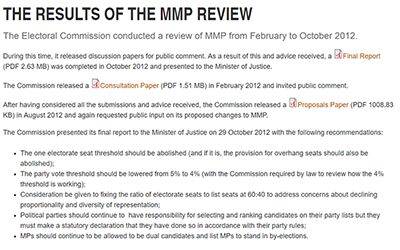
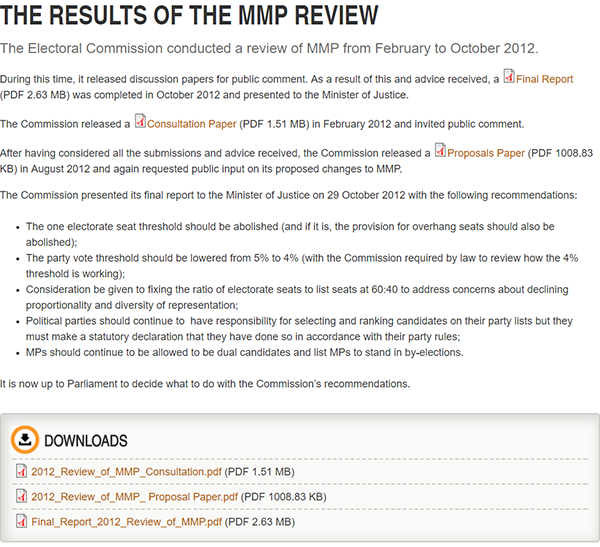
Absolutely Nothing: Come Saturday week, Labour, but particularly the Greens, may regret failing to die-in-a-ditch over National’s refusal to action the timid-enough recommendations of Electoral Commission New Zealand. image Electoral Commission New Zealand
Gareth Morgan’s failure to crash last Friday’s leaders debate drew attention to the inescapable.
His briefly promising political initiative hasn’t come close to breaking the 5%-threshold barrier to tyro parties, and will not make it into Parliament. But nor, possibly, will the Greens.
The particularly perverse feature of New Zealand’s mixed-member-proportional implementation is that supporters of minor parties are forced to choose between the party that best represents their heart or their policy preferences, and a lesser-of-two-evils-major-party option, for fear that their all-important party vote be wasted. It is perverse because it is totally unnecessary.
All that is required to remove the risk of vote wasting is to allow voters to express not just their first preference, but to also record their secondor third, et cetera preferences preference. Electoral officials in Aotearoa are already adept in the counting of preference votes, since 2004, when the system was introduced at local government levelin 2016 it was used by four city, two district, and one regional council and made mandatory for district health boards.
The New Zealand National Party is no fan of the mixed-member system, despite their Te Kūiti-boythe writer, also a Te Kūiti-boy, if casting aspersions, entirely shares in those Jim Bolger opening the door to it. But nor has the Labour Party embraced coalition government, and has been particularly brutal on the Greens. When the latest opportunity presented to address its more obviously aberrant aspects, the National-led government cynically announced there was no political consensus to implement the inquiry’s recommendations. National is on track to receive fewer party votes than Labour. If, as could well happen, Labour lacks the Green Party as a coalition partner because it failed the 5% thresholdand its surviving co-leader persisted with contesting an unwinnable seat, National could form yet another government, with master of mixed-member manipulation, Winston Peters.
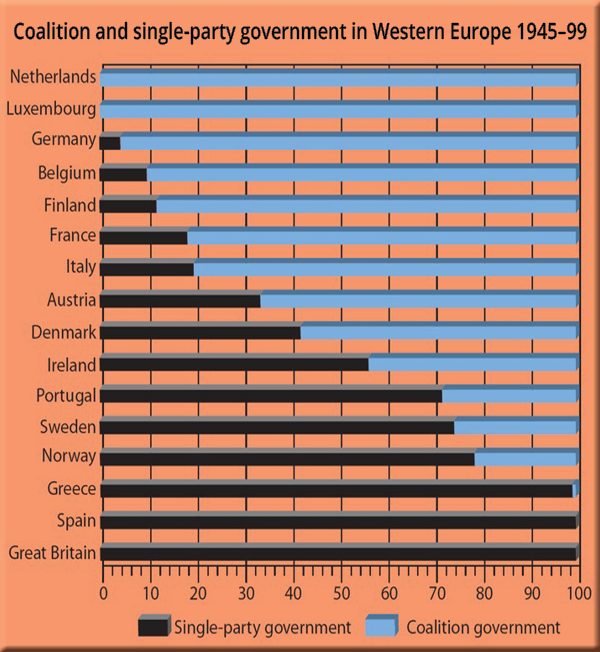
Others Play Nicely: While Western Europe has a long history of coalitions, New Zealanders, after the grand coalition of World War II, went most of the balance of the 21st century with only single-party governments, and it shows in the current two-party scrabble. chart Mūller and Strøm, 2000 Labels Mahurangi Magazine
If it came about in those circumstances, a National-led government post 23 September would be an outrage that would further disillusion New Zealanders about their democracy and add to future voter-turnout decline. Shamefully, the Green Party, when it had the opportunity to condemn the 5% threshold, cynically suggested a mere tinkering, a reduction to 4%—a slight lowering of the ladder, but not so much not so much as to need to defend itself from younger, hungrier new parties. As for supporting preference party-voting, the Greens were no more use than the other established parties in changing the rules under which they have prevailed, to allow outsiders a fair contest.
Short of the lengthy process of electoral system change, there is an alternative to allowing a party that has recently polled as low as 6.6% to dictate whether Labour or National forms the next government. New Zealand First only enjoys its current disproportionate power because support for the major parties is split more-or-less evenly between the big two. It is testament to the recentness of their experience with coalition government that it is unthinkable to New Zealanders that, there being no clear winner between the two major parties, that they are not expected to share the task of government. Germany has been doing exactly that for the last 12 years, and will possibly do so for a further four years, given that as recently as April the two dominant parties were neck and neck. However, with Angela Merkel’s Christian Democratic Union – Christian Social Union group currently polling a 16-percentage-point margin over its coalition partner, the latter, the Social Democratic Party, may find itself in the wilderness post 24 September. But if it does find itself out of power, with its support in the low 20s it would not be the equivalent of National, hovering at the 40% line, being entirely shut out of government.
Given the unlikelihood of grand coalition government in Aotearoa anytime soon, voters wishing to see Labour lead the next government face a Green horns-of-a-dilemma: Vote Green in the hope that up to 5% of the vote won’t be wasted, or vote directly for Labour, and know that the vote will count, but might not leave Labour in a position to form a government.
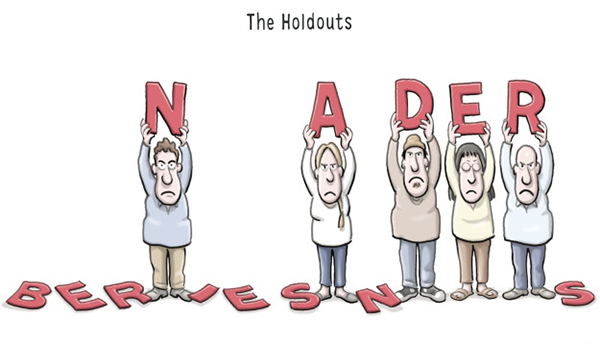
Unsafe at Any Distance: Even without contesting the last two presidential elections, Ralph Nader may have helped Trump, thanks to the perverse, first-past-the-post system that the country that styles itself as the first modern democracy repeatedly fails to fix. cartoon Clay Bennett | Chattanooga Times Free Press
In the United States, in 2008, fortunately without remotely effecting the outcome, Ralph Unsafe at Any Speed Nader stood against the first African American presidential candidate to receive the nomination of a major political party. Eight years earlier, Nader, who ascribes to the no-vote-is-a-wasted-vote philosophy adopted by Gareth Morgan, helped, along with a final push from the Supreme Court, Al Gore lose to George ‘Back-Rub’ Bush. With all realistic chances of the Opportunities Party cresting the 5% threshold evaporatingverb omitted, until 1 November 2020— oh for a subeditor!, Morgan has switched to telling his supporters they should knock themselves out voting for any of the Opportunities Party’s electoral candidates where it won’t hurt Labour or National, in an effort to deny Winston Peters the kingmaker role. Ironically, the only Opportunities Party candidate that ever stood even the slightest chance of taking an electorate seat was the big kahuna hisself, but Morgan has long since sworn to stand only on the list.
Curiously, political scientists insist on studying vote splitting from only one end—the end that assumes that most voters know that the party vote is all-important. Unfortunately, in countries new to the mixed-member system, which include Scotland, every other voter misunderstands the purpose of the party vote, mistaking it for a second, party, preference. The Electoral Commission New Zealand provides the statistics, electorate by electorate, of the electorate votes of party-voters went in 2014. For example, only 66% of those who party-voted Labour in Rodney also gave their electorate vote to the Rodney Labour Party candidate. But the equally important statistic, given that half are under the misapprehension that the electorate vote is all-important, is which other parties benefit from the party vote of those voters. Those statistics would be useful in estimating, for example, what percentage of Rodney voters in 2017:
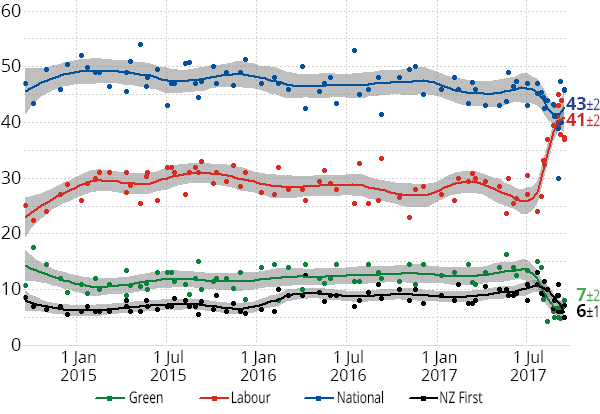
Small Margin for Error: With the Green Party polling, at the lower end of the margin of error, 3% (as at midnight 22 September) there is real risk of it wasting up to 158 000 of the votes needed for there to be a change of government. While National carries most of the culpability for the 5% threshold not being addressed, the Green Party was also happy for it to stay more-or-less intact—a triumph of self-interest over the interest of New Zealanders. chart Wikipedia adapted by Mahurangi Magazine
- Give their electorate vote to Labour Party candidate Marja Lubeck, believing that they have voted Labour and the Labour candidate, and
- Give their party vote to the Green Party, as the other party they wish to support, as Labour’s coalition partner.
It bears repeating: In this example, the voters have just voted Green; the Labour Party has gained no benefit whatsoever. Were the statistics available from Electoral Commission New Zealand, the example could be quantified—it would be indicatedindicated, because it can’t be known exactly what is in a voter’s mind, after the event, exactly how many voted for the Green Party imagining they were voting for Labour.
Meantime, it is preposterous that the 5% threshold forces Green and Labour party supportersat least those who do understand the primacy of the party vote to gamble on helping the Greens over the line, only to, possibly, deprive Labour of the support it needs to be in government.
Electoral system mechanics is an arcane subject which need interest few people. Those responsible—primarily, the electoral commission—should be trusted to recommend any tweaks and changes required to ensure that it is fit-for-service. But where this breaks down is when the foxes are left in charge of the henhouse, and brazenly protect their own interest. Winston Peters, for example, along with the National Party, opposed even a token lowering of the 5% threshold, or the abolishment of the coattails provision. It was shamelessly spun by National as a failure by the other parties to agree to the commission’s recommendations, probably abetted by the same evil genius who masterminded Steven Joyce’s wilfully false claim of a $11.7 billion hole in Labour’s election promises.
Chairman of the Electoral Commission New Zealand, Sir John Hugh Williams QC, has just been reappointed for a further 18 months. Considering the disrespect paid to his commission’s recommendations, the fulsome support spouted by Louise Upston, on behalf of the Associate Minister of Justice, Rodney Electorate representative Mark Mitchell, is breath-taking in its hypocrisy.
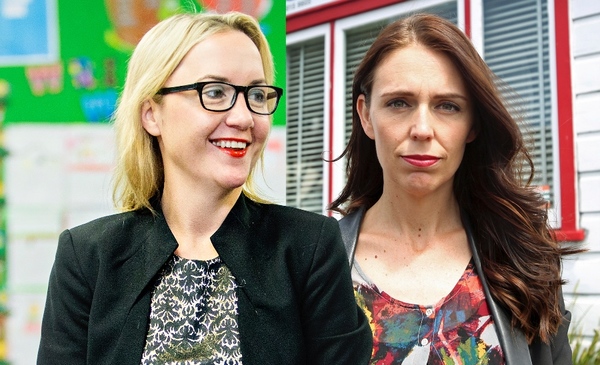
Wasted Years: Had the Greens and first-past-the-post not robbed Jacinda Ardern of Auckland Central in 2014, the Labour Party may well have had a charismatic and electable leader in position for several years, rather than seven weeks, ahead of the election—wasted years thanks to first-past-the-post wasted votes. image Charlotte Curd | Fairfax NZ
While mixed-member has successfully introduced proportionality to New Zealand’s electoral system, it cannot be said to be fit-for-service while it retains the first-past-the-post method of recording voters’ preferences. In addition to the party-vote-wasting guaranteed by Opportunities, and the potential waste of up to 125 000 Green party-votes mentioned, first-past-the-post also produces perverse results in some electorate competitions. In Central Auckland, in 2014, Jacinda Ardern narrowly lost to Nikki Kaye, thanks to wasted Green votes. Had preference voting rather than first-past-the-post been used, Ardern would have enjoyed a margin of about 1400 votes.
But in addition to addressing third-horse and below-the-threshold wasted votes, preference voting solves the otherwise insurmountable challenge of educating the one-in-two voters that have it wrong that the party vote is all-important. By allowing voters to rank both party and electoral candidates, rather than tick just one of each, it is unimportant as to whether a voter imagines that, in the above example, by voting ARDERN, Jacinda labour party, they have just voted for Labour. They have not, unless they also give Labour their party-vote tick.
The only circumstances where the utter crudity of first-past-the-post isn’t an impediment to a fair outcome is a two-horse race—as long as there are no more than two choices, preference voting is not required. In every other contest, preference voting is the only fit-for-service method. Ten years ago, when the need to fix the electoral system was stated to a Labour Party list member assigned to Rodney, the Mahurangi Magazine was asked:
With their potential coalition partner’s polling stubbornly in the doldrums, risking the waste of up to 125 000 votes, Labour, come Saturday week, may have reason to deeply rue its indifference to fixing mixed-member’s deficiencies. And if cost of making the change is a consideration, in addition to concurrent elections there are numerous smart ways that wasteful electoral practices could be eliminated.
Change-of-government voters face a vicious, three-horned dilemma:
- Party-vote Greens, and risk wasting that party vote;
- Fail to party-vote Green, and discover that a handful more Green votes would have saved up to 125 000 being wasted; or
- Party-vote Labour knowing that the vote will count, but Labour might fail to form a government, for want of a coalition partner.
Preference voting would have eliminated the need for voters to gamble, so, in its absence, option three would appear to be the least risky option.
